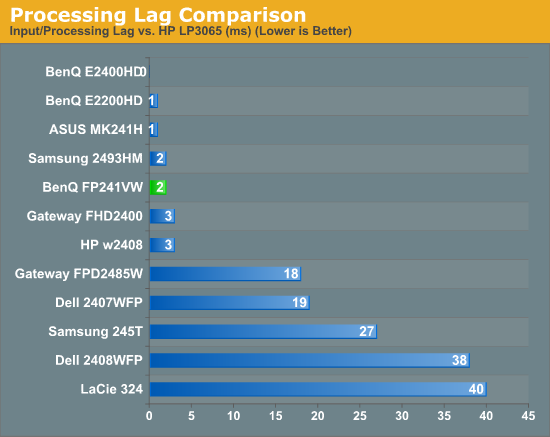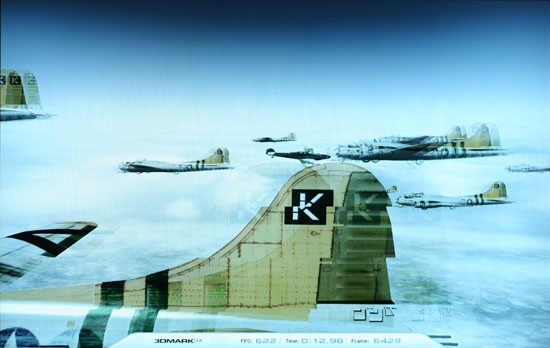Display Lag and Response Time
One of the areas where the A-MVA panel does extremely well is in the areas of display lag and pixel response time. Just to recap, you may have heard complaints about "input lag" on various LCDs, so that's one area we look at in our LCD reviews. We put input lag in quotation marks because while many people call it "input lag", the reality is that this lag occurs somewhere within the LCD panel circuitry, or perhaps even at the level of the liquid crystals. Where this lag occurs isn't the concern; instead, we just want to measure the duration of the lag. That's why we prefer to call it "processing lag" or "display lag".
To test for display lag, we run the Wings of Fury benchmark in 3DMark03, with the output set to the native LCD resolution - in this case 1920x1200. Our test system is a quad-core Q6600 running a Radeon HD 3870 on a Gigabyte GA-X38-DQ6 motherboard - we had to disable CrossFire support in order to output the content to both displays. We connect the test LCD and a reference LCD to two outputs from the Radeon 3870 and set the monitors to run in clone mode.
The reference Monitor is an HP LP3065, which we have found to be one of the best LCDs we currently possess in terms of not having display lag. (The lack of a built-in scaler probably has something to do with this.) While we know some of you would like us to compare performance to a CRT, that's not something we have around our offices anymore. Instead, we are looking at relative performance, and it's possible that the HP LP3065 has 20ms of lag compared to a good CRT - or maybe not. Either way, the relative lag is constant, so even if a CRT is faster at updating, we can at least see if an LCD is equal to or better than our reference display.
While the benchmark is looping, we snap a bunch of pictures of the two LCDs sitting side-by-side (using a relatively fast shutter speed). 3DMark03 shows the runtime with a resolution of 10ms at the bottom of the display, and we can use this to estimate whether a particular LCD has more or less processing lag than our reference LCD. We sort through the images and discard any where the times shown on the LCDs are not clearly legible, until we are left with 10 images for each test LCD. We record the difference in time relative to the HP LP3065 and average the 10 results to come up with an estimated processing lag value, with lower numbers being better. Negative numbers indicate a display is faster than the HP LP3065, while positive numbers mean the HP is faster and has less lag.
It's important to note that this is merely an estimate - whatever the reference monitor happens to be, there are some inherent limitations. For one, LCDs only refresh their display 60 times per second, so we cannot specifically measure anything less than approximately 17ms with 100% accuracy. Second, the two LCDs can have mismatched vertical synchronizations, so it's entirely possible to end up with a one frame difference on the time readout because of this. That's why we average the results of 10 images, and we are confident that our test procedure can at least show when there is a consistent lag/internal processing delay. Here is a summary of our results for the displays we have tested so far.
 |
| Display Input/Processing Lag vs. HP LP3065 | |||||||||||
| One | Two | Three | Four | Five | Six | Seven | Eight | Nine | Ten | Avg. (ms) | |
| ASUS MK241H | 10 | 0 | 0 | 0 | 0 | 0 | 0 | 0 | 0 | 0 | 1 |
| BenQ E2200HD | 0 | 0 | 0 | 10 | 0 | 0 | 0 | 0 | 0 | 0 | 1 |
| BenQ E2400HD | 0 | 0 | 0 | 10 | -10 | 0 | -10 | 0 | 0 | 10 | 0 |
| BenQ FP241VW | 0 | -10 | 0 | 10 | 0 | 10 | 0 | 0 | 10 | 0 | 2 |
| Dell 2407WFP | 10 | 20 | 30 | 20 | 10 | 10 | 30 | 30 | 10 | 20 | 19 |
| Dell 2408WFP | 30 | 40 | 40 | 40 | 30 | 30 | 40 | 30 | 50 | 50 | 38 |
| Gateway FHD2400 | -10 | -10 | 0 | 10 | 10 | 10 | 0 | 10 | 10 | 0 | 3 |
| Gateway FPD2485W | 30 | 10 | 20 | 20 | 20 | 10 | 0 | 30 | 20 | 20 | 18 |
| HP w2408 | 10 | 10 | 0 | 0 | 0 | 0 | 0 | 10 | 0 | 0 | 3 |
| LaCie 324 | 40 | 30 | 40 | 30 | 40 | 50 | 40 | 50 | 50 | 30 | 40 |
| Samsung 245T | 30 | 30 | 30 | 30 | 30 | 20 | 30 | 30 | 20 | 20 | 27 |
| Samsung 2493HM | 0 | 10 | 0 | 0 | 0 | 10 | 0 | -10 | 0 | 10 | 2 |

As you can see, all of the S-PVA panels we have tested to date show a significant amount of input lag, ranging from 20ms up to 40ms. In contrast, the TN and S-IPS panels show little to no processing lag (relative to the HP LP3065). The BenQ FP241VW performs similarly to the TN and IPS panels, with an average display lag of 2ms - not something you would actually notice compared to other LCDs. Obviously, if you're concerned with display lag at all, you'll want to avoid S-PVA panels for the time being. That's unfortunate, considering S-PVA panels perform very well in other areas.
 |
Despite what the manufacturers might advertise as their average pixel response time, we found most of the LCDs are basically equal in this area - they all show roughly a one frame "lag", which equates to a response time of around 16ms. In our experience, processing lag is far more of a concern than pixel response times. Taking a closer look at just the FP241VW, we can see the typical one frame lag in terms of pixel response time. However, the panel does appear to be a little faster in response time than some of the other panels we've tested (notice how the "ghost image" isn't as visible as on the HP LP3065), and we didn't see parts of three frames in any of the test images.
Update: What Causes Display Lag?
After the initial article went live, one of our readers who works in the display industry sent me an email. He provides some interesting information about the causes of image lag. Below is an (edited) excerpt from his email. (He wished to remain anonymous.)
PVA and MVA have inherent drawbacks with respect to LCD response time, especially gray-to-gray. To address this shortcoming, companies have invested in ASICs that perform a trick generically referred to as "overshoot." The liquid crystal (LC) material in *VA responds sluggishly to small voltage changes (a change from one gray level to another). To fix this, the ASIC does some image processing and basically applies an overvoltage to the electrodes of the affected pixel to spur the LC material into rapid movement. Eventually the correct settling voltage is applied to hold the pixel at the required level matching the input drive level.
It's very complicated math taking place in the ASIC in real time. It works well but with an important caveat: it requires a frame buffer. What this means is that as video comes into the panel, there is a memory device that can capture one whole video frame and hold it. After comparing it to the next incoming frame, the required overshoot calculations are made. Only then is the first captured frame released to the panel's timing controller, which is when the frame is rendered to the screen. As you may have already guessed, that causes at least one frame time worth of lag (17ms).
Some companies discovered some unintended artifacts in their overshoot calculations and the only way they saw to correct these was to allow for their algorithm to look ahead by two frames instead of one. So they had to up the memory of the frame buffer and now they started capturing and holding not one but two frames upon which they make their complex overshoot predictions to apply the corrected pixel drive levels and reduce gray-to-gray response time (at the expense of lag time). Again, it works very well for improving response time, but at the expense of causing lag, which gamers hate. That in a nutshell is the basis of around 33ms of the lag measured with S-PVA.
[End Excerpt - the following is not from our reader]
Not every display uses this approach, but this could account for the increase in display lag between earlier S-PVA and later S-PVA panels. It's also important to note that I tested the Dell 2408WFP revision A00, and apparently revision A01 does not have as much lag. I have not been able to confirm this personally, however. The above also suggest that displays designed to provide a higher image quality through various signal processing techniques could end up with more display lag caused by the microchip and microcode, which makes sense. Now all we need are better algorithms and technologies in order to reduce the need for all of this extra image processing -- or as we have seen with some displays (particularly HDTVs), the ability to disable the image processing.










114 Comments
View All Comments
praeses - Wednesday, June 17, 2009 - link
After using this particular monitor as my primary display at home for well over a year I have fairly decent experience with it. Nearly all of my concerns are reflected in this review. Having said that there are a few aspects I would like to point out:The input lag varies significantly from inputs and resolution. Using DVI at 1920x1200 yields the lowest while analogue at any other resolution is significantly higher. Using any of the different lighting modes adds lag as well. For my purposes I have them turned off.
VGA also seems to be quite washed out. It has troubles with certain timings as well including XBOX360 where it cannot compensate for the overscan. The composite inputs are reasonable although when scaled any signal distortion is amplified significantly.
Of course, the fluorescent backlight is annoying. As a previous commenter has implied that using LCDs do not result in headaches, that is far from the truth. Once manufacturers move towards LED backlighting hopefully some of that will be alleviated. To date I have been unsuccessful at tracking down a suitable LED panel to swap into this monitor. The non-adjustable backlighting is also significantly annoying in low light conditions with some bleeding, although fairly consistent throughout the panel appearing gray.
The headphone connection only working for audio over HDMI just seems silly. They should have included an analogue pass-through.
Prior to purchasing this monitor I was aware of most of these issues and they are consistent between screens. Some people have buyer's pride and dismiss it or do not see them to begin with. Despite this, I am quite happy with this monitor and have not found a better replacement for my uses where viewing angles, input lag (over DVI), and composite inputs are paramount.
Spacecomber - Wednesday, June 17, 2009 - link
I think the reason that the trend with LCDs is simply to make them cheaper and not better has a lot to do with there being no meaningful specifications that the consumer can use to compare one monitor to another. In many cases, you can't even tell what kind of panel is being used. (Imagine buying a CRT monitor and not being able to easily tell whether it was a shadow-mask or an aperture grill tube.)With no meaningful information about the monitor in its technical specifications, the only thing the consumer can easily determine is relative price differences.
At this point, it is pretty clear that the industry manufacturing LCDs has no motivation to redress this on their own. I don't know who might be in the best position try to change this, but outside pressure (if not outright regulation) needs to be applied, if there is any hope of making manufacturers compete on a level playing field, when it comes to what a particular monitor really is capable of.
I suspect that respected professional computer hardware review publications, such as Anandtech, could wield some clout in pursuit of this end, and I hope that they pick up the banner.
darklight0tr - Wednesday, June 17, 2009 - link
I agree. The panel type should be disclosed in the specifications for all LCDs so the consumer knows what they are getting. Right now you have trudge through the bowels of the Internet just to find what panel is being used for a particular display, since most of the time it isn't disclosed.The technical specifications are also suspect because the "tests" used aren't standardized or controlled in any meaningful fashion. That's how you can have 2ms LCDs that really are 10ms or higher. Same thing with contrast ratios, especially dynamic ones. I'm just waiting for the LCD that has Infinity:1 contrast ratio. That's the one for me!
tomoyo - Wednesday, June 17, 2009 - link
Companies will never do this for one big reason. Profit. They profit from the lack of real specifications on lcds that allows them to make even low end lcds seem to be good. And most people don't care at all. We're the few that actually try to give good advice on avoiding crap lcds, but we can't fight against the huge tide of mindless consumers.JarredWalton - Wednesday, June 17, 2009 - link
Don't forget the other reason a lot of companies don't like to disclose the type of LCD panel they use: they don't want to be "locked in" to a specific LCD panel. If they were to advertise that the display uses, for example, an S-PVA panel, they wouldn't be able to switch to less expensive TN down the road -- or perhaps IPS or MVA. High quality displays generally don't change panels midway through the production run, but the same can't be said of less expensive models.tomoyo - Wednesday, June 17, 2009 - link
No kidding. I remember all that panel lottery madness with those Samsung TN-films such as the 226BW. It was ridiculous when there were 4 possible panels you could receive from one monitor model. Same thing with the Dell IPS/S-PVA lottery from long ago. It's dishonest how little they care about the quality of the product that we get.I'm glad my friend got a Benq FP241W with a similar MVA panel to the one you just reviewed a couple years ago for around $600. Probably the best pickup for a 24" at the time. (and he was lucky not to experience problems like some have).
alexdi - Wednesday, June 17, 2009 - link
The lag numbers for the Dell 2408WFP are incorrect as of revision A01, which replaced A00 four months ago. A01 lag is significantly reduced and identical to the 2407WFP A04. I have had all three screens at once to verify this.fmyhr - Wednesday, June 17, 2009 - link
http://www.kwiksurveys.com/online-survey.php?surve...">http://www.kwiksurveys.com/online-survey.php?surve...If you would like to be able to buy a ThinkPad or other business-class notebook with a premium screen, please take the survey at the above url when you can spare a couple of minutes.
Survey results are here:
http://forums.lenovo.com/lnv/board/message?board.i...">http://forums.lenovo.com/lnv/board/mess...al_Inter...
Thanks for your help!
GTaudiophile - Wednesday, June 17, 2009 - link
I spent a few months doing research, trying to find a 24" replacement for my really old DELL 2001FP.It more or less came down to the DELL 2408WFP and the HP LP2475w. But I just read too many negative reviews, calibration issues, etc. to feel that either was a safe bet of my $550.00 USD.
What am I looking for? 24". 1920x1200. 1080P. 16:9. Something "approved" by photographers for photo editing / color accuracy. But something that can also be a decent gaming monitor when needed. Something that will allow me to be on the net for hours without causing too much eye fatigue. And finally costs around $500 or less.
In the end, I quit my search for now, unsatisfied with current market offerings. If the "Stickied LCD" thread in the Video Cards & Graphics forum is any indication, I am not the only frustrated person out there.
haplo602 - Wednesday, June 17, 2009 - link
I want to buy the HP screen you mentioned. What negatives did you find about it ? I did only find favorable reviews.